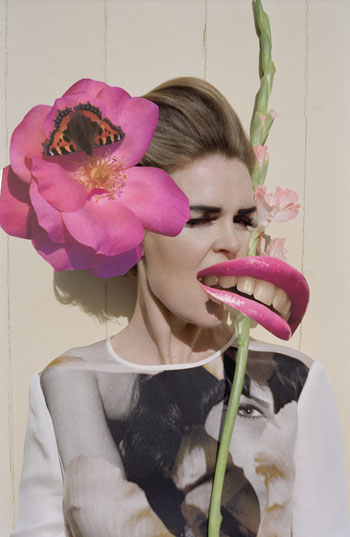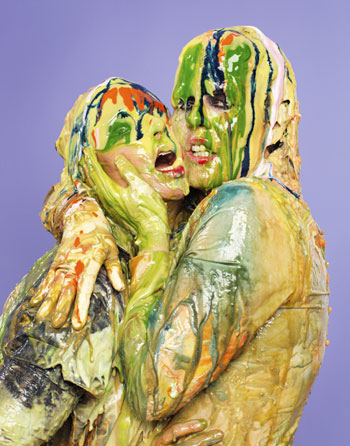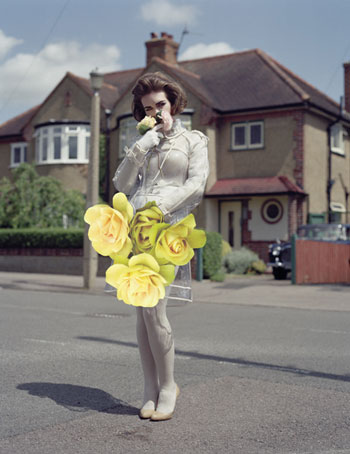by Erik Matiny
About Erik Martiny
 Erik Martiny's reviews have appeared in London Magazine and The Times Literary Supplement. He lives in France.
Erik Martiny's reviews have appeared in London Magazine and The Times Literary Supplement. He lives in France.
 The circular structure of the exhibition space accommodating this retrospective of Sterling Linder’s work is perfectly suited to her unwavering interest in collage over the last thirty years: from the first scalpel-cut, hand-assembled images of the seventies to her more recent Photoshop-assisted photomontages. Most of the exhibits on display derive from Linder’s decision to cross a pile of women’s domestic magazines with men’s pornography magazines to see what kind of hybrid creature would emerge.
The circular structure of the exhibition space accommodating this retrospective of Sterling Linder’s work is perfectly suited to her unwavering interest in collage over the last thirty years: from the first scalpel-cut, hand-assembled images of the seventies to her more recent Photoshop-assisted photomontages. Most of the exhibits on display derive from Linder’s decision to cross a pile of women’s domestic magazines with men’s pornography magazines to see what kind of hybrid creature would emerge.
The most common motifs used by Linder are flowers and cakes pasted onto the faces or genital organs of the women borrowed from the pornographic magazines she modifies. Linder’s official intention is to undermine male-centered fantasies to reveal the underlying ideology that hampers women’s freedom and offers them up for consumption by the male gaze.
The result, however, seems often far from satisfactory from a purely ideological view as the collaged images she produces remain overtly pornographic, if not even more so, after they have been tampered with. A naked woman with a vaginal rose instead of a head comes across as more of a fertility symbol or a surreal erotic fantasy than a damning indictment of patriarchy. The large neon letters that appear half-way through the show, ‘Anatomy Is Not Destiny’, indicate the way the images are intended but their iconography ultimately seems to escape the artist’s control.
 Linder’s most unequivocal feminist statements date back to her beginnings: her collage entitled Salade (1977) depicts a bowl with lettuce and tomatoes that on closer inspection turn out to be women’s lips; an olive reveals itself to be a staring, terrified-looking eye. Other works show blown up facial shots of women looking out through doorways and windows as if they are Alice grown too large for their houses; still others have household implements such as forks sticking into their eyes. These early examples clearly and unambiguously suggest male aggression or the oppressive nature of gender-specific roles.
Linder’s most unequivocal feminist statements date back to her beginnings: her collage entitled Salade (1977) depicts a bowl with lettuce and tomatoes that on closer inspection turn out to be women’s lips; an olive reveals itself to be a staring, terrified-looking eye. Other works show blown up facial shots of women looking out through doorways and windows as if they are Alice grown too large for their houses; still others have household implements such as forks sticking into their eyes. These early examples clearly and unambiguously suggest male aggression or the oppressive nature of gender-specific roles.
The problem lies in the fact that Linder pursues two rival aesthetic goals at the same time in most of her works. She is a feminist but she is also quite obviously an eroticist with a fascination for displaying and enhancing female nakedness. Another element which complicates a straightforward identification of Linder as a feminist is the fact that her exploration of sexuality is also humorous: her pornographic cake series features images of various pastries standing in for genitalia.
Some of Linder’s recent Photoshop imagery does find a good compromise between eroticism and ideology. Models covered from head to foot so as to be virtually unrecognizable in what looks like a mixture of paint, sperm and runny cheese can be read as oppressive or phantasmagoric without seeming to partake in the pornography industry it purports to condemn.
 But the gender-bending triumph came outside the exhibition itself in the dance performance choreographed by Kenneth Tindall down in the basement of the museum to honour the opening night of Linder’s show. Moving in groups of twos and threes, dancers entered the arena dressed in coloured suits that evoked the undulating striations of sculptured wood. Extended headwear made them strange and tree-like in appearance. Although all the dancers were scrupulously expressionless, the dancer dressed in brown had a glazed, vacuous gaze that made her express something almost funereal. The dancer in green was livelier and the performer in pink wood patterns was positively electric. The men wore metal-coloured costumes and held each other in poses traditionally reserved for male-female interaction. The originality of their gestures was most harmoniously choreographed, but this elegance was often deliberately undercut by poses which pushed the dancers’ physical limits as far as they could go, sometimes evolving into monstrous combinations of bodies evoking hybrid fusion between species. The musical accompaniment (composed by Stuart Mc Callum), performed by a double bass and an electric guitar, expressed a futuristic world steeped in a strangeness which was more pleasant and portentous than disturbing. Entitled ‘The Ultimate Form’, the performance was inspired by the work of the sculptress Barbara Hepworth, but came as a welcome accompaniment to the many collages that evoked the Cake Walk and other dance styles.
But the gender-bending triumph came outside the exhibition itself in the dance performance choreographed by Kenneth Tindall down in the basement of the museum to honour the opening night of Linder’s show. Moving in groups of twos and threes, dancers entered the arena dressed in coloured suits that evoked the undulating striations of sculptured wood. Extended headwear made them strange and tree-like in appearance. Although all the dancers were scrupulously expressionless, the dancer dressed in brown had a glazed, vacuous gaze that made her express something almost funereal. The dancer in green was livelier and the performer in pink wood patterns was positively electric. The men wore metal-coloured costumes and held each other in poses traditionally reserved for male-female interaction. The originality of their gestures was most harmoniously choreographed, but this elegance was often deliberately undercut by poses which pushed the dancers’ physical limits as far as they could go, sometimes evolving into monstrous combinations of bodies evoking hybrid fusion between species. The musical accompaniment (composed by Stuart Mc Callum), performed by a double bass and an electric guitar, expressed a futuristic world steeped in a strangeness which was more pleasant and portentous than disturbing. Entitled ‘The Ultimate Form’, the performance was inspired by the work of the sculptress Barbara Hepworth, but came as a welcome accompaniment to the many collages that evoked the Cake Walk and other dance styles.
East Villager Billy The Artist Climbs Atop Ai Wei Wei's Fence To Shine A Light On It
A Quick Note on Transplants: Greek Diaspora Artists
Teddy Thompson’s Ultimate Funeral Mix Tape
Moray Hillary, Pre-New Reflective by Heather Zises
SELFISH, Review by Heather Zises
Winter Realm Series by Noah Becker
Paul Rousso at Lanoue Fine Art
Airan Kang, The Luminous Poem at Bryce Wolkowitz Gallery
Damien Hoar De Galvan at Carroll and Sons
Antigone, 2015, directed by Ivo van Hove
Karen Jerzyk's unsettling Parallel World
CEK - Concrete Functional Sculptures
Alexis Dahan, ALARM! At Two Rams
Do Ho Suh, Drawings, at Lehmann Maupin
Nir Hod, Once Everything Was Much Better Even the Future
Exhibition Review: Mario Schifano 1960 – 67
Subverting the Realist Impulse in the Work of Shauna Born
Accumulation: Sculptural work by Alben at Gallery Nines
What We Do in the Shadows by Jemaine Clement and Taika Waititi
Justin Kimball at Carroll and Sons
Told & Foretold: The Cup in the Art of Samuel Bak, at Pucker Gallery
Collective Memory Manipulated: Sara Cwynar’s Flat Death
Art Paris Art Fair 2013 Review
Paris Street Art Musée de la Poste
Trellises by Katherine Tzu-Lan Mann
Topography of Destruction Kemper Museum
L'art en Guerre : France 1938-1947
The Louvre Relocates to Africa
A French Priest, Tears and Fire the Art of Jean-Michel Othoniel
